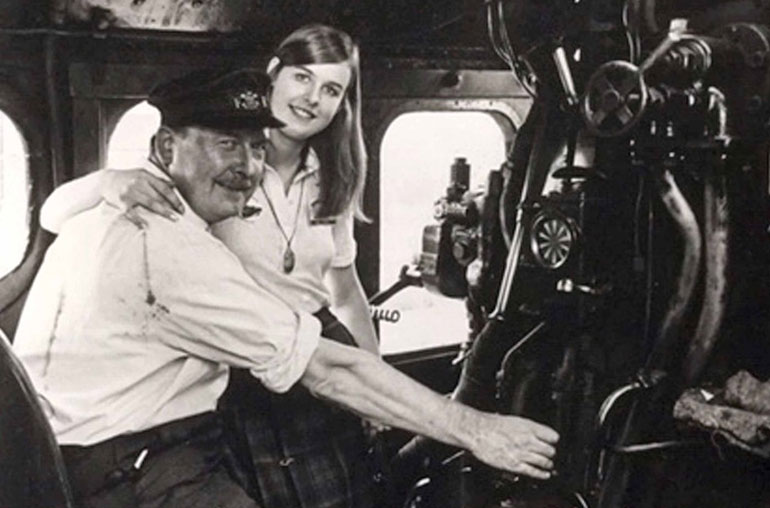Flying Scotsman

Caption: Area damaged by fire and sand lizard on affected area at Upton Heath © Simon Cripps
Culture, Dorset, History, Purbeck | Posted on February 22nd, 2019 | return to news
Flying Scotsman to be waved off by daughter of man who saved the iconic locomotive from scrapyard
The daughter of the man who saved ‘Flying Scotsman’ from the scrapyard is to wave off the world’s most famous locomotive at the start of its visit to the Isle of Purbeck.

Caption:17-year-old Penny with her father on ‘Flying Scotsman’
Penny Vaudoyer will be flying in from her home in Portugal to wave off the world’s most famous steam locomotive when it hauls its first train on the Swanage Railway at the start of its three-week visit to the Isle of Purbeck.
She will perform the honour with the train guard’s green flag on Swanage station at 10.05 am on Friday 22 March.
It was her enterprising and charismatic father, the late Alan Pegler, who purchased ‘Flying Scotsman’ from British Railways for the scrap value of £3,000 in 1963.
While visiting Swanage, the iconic 1920s’ A3 class express engine – owned by the National Railway Museum in York – will be reunited with a rare late 1940s’ Devon Belle Pullman observation carriage, known as Car 14, for the first time in almost 50 years.
Penny said, “It will be a very moving moment for me to see the ‘Flying Scotsman’ and its Pullman observation carriage again because I have so many wonderful memories. That’s why I am so happy to be coming to Swanage to send off the first train of the day – quite an honour.
“‘Flying Scotsman’ – or ‘Scotty’ as we called her – was part of the family and as for the Pullman observation carriage Car 14, I have just so many memories. I crossed the Rocky Mountains with ‘Flying Scotsman’ as a teenager and spent many hours watching the magnificent scenery from that end carriage.”
Thanks to Pegler’s drive and determination, between 1969 and 1972 ‘Flying Scotsman’ ran with the Devon Belle Pullman observation carriage Car 14 in the United States of America during a tour of the country aimed at promoting British exports.
Penny recalled, “My father was a kind and generous man who had time for everyone from all walks of life – a real gentleman who was accessible and friendly to everyone.
“He lived his passion and his dream to the hilt and, despite the risks and losses and the rollercoaster ride of business life with ‘Flying Scotsman’, he was always cheerful and never complained.”
Completed in 1923 by the London and North Eastern Railway (LNER), the 97-tonne No 60103 ‘Flying Scotsman’ will be on the Swanage Railway for 20 days from 22 March to 10 April.
The first five days will see the locomotive haul trains between Swanage, Corfe Castle and Norden with Devon Belle Pullman observation carriage Car 14 being coupled behind ‘Flying Scotsman’.
From 27 March until 10 April, 2019, the iconic steam locomotive and the Devon Belle Pullman observation carriage Car 14 will be on static display at Corfe Castle station with ticket-only access to board.
Sadly, the company running the 1969 to 1972 British exports promotion trains tour went bankrupt with ‘Flying Scotsman’ being rescued and returned home in 1973, by William McAlpine, while the rare Pullman observation carriage Car 14 remained in the USA.
Dedicated Swanage Railway volunteers rescued the late 1940s’ Devon Belle Pullman observation carriage – known as Car 14 – from San Francisco during 2007 where it was being used as a company boardroom.
Swanage Railway Company business division director, volunteer train guard and signalman, Mick Gould said, “Everyone is delighted, and honoured, that the daughter of the man who saved No 60103 ‘Flying Scotsman’ from the scrapyard in the 1960s is to wave off the iconic steam locomotive’s first train from Swanage.
“We look forward to welcoming Penny Vaudoyer to the Swanage Railway and sharing her wonderful memories of ‘Flying Scotsman’, the Devon Belle Pullman observation carriage Car 14 and her late father Alan Pegler to whom we owe a debt of gratitude.”
Purchased by the National Railway Museum in 2004, ‘Flying Scotsman’ was restored thanks to a £4.2 million, ten-year project funded by the National Heritage Memorial Fund and the Heritage Lottery Fund as well as from public donations.
Please share post:
READ NEXT
LATEST NEWS








